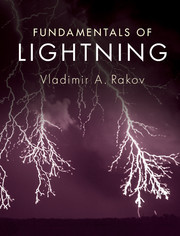Description
Fundamentals of Lightning
Author: Rakov Vladimir A.
Presents the current state of the art in lightning science, for advanced undergraduate and graduate students on a single-semester course.
Language: English
Subject for Fundamentals of Lightning:
Publication date: 04-2016
248 p. · 19.3x25.2 cm · Hardback
248 p. · 19.3x25.2 cm · Hardback
Description
/li>Contents
/li>Biography
/li>
This new book provides a focused set of topics suitable for advanced undergraduate or graduate courses on lightning. It presents the current state of the art in lightning science including areas such as lightning modeling, calculation of lightning electromagnetic fields, electromagnetic methods of lightning location, and lightning damaging effects and protective techniques. Pedagogical features designed to facilitate class learning include end-of-chapter summaries, further reading suggestions, questions and problems, and a glossary explaining key lightning and atmospheric electricity terms. A selection of appendices are provided at the end of the book, which include detailed derivations of exact equations for computing electric and magnetic fields produced by lightning. Designed for a single-semester course on lightning and its effects, and written in a style accessible to technical non-experts, this book will also be a useful, up-to-date reference for scientists, engineers and practitioners who have to deal with lightning in their work.
Dedication; Preface; 1. Types of lightning discharges and lightning terminology; 2. Incidence of lightning to areas and structures; 3. Electrical structure of thunderclouds; 4. Properties of the downward negative lightning discharge to ground; 5. Calculation of lightning electromagnetic fields; 6. Modeling of lightning processes; 7. Measurement of lightning electric and magnetic fields; 8. Electromagnetic methods of lightning location; 9. Lightning damaging effects and protective techniques; Appendix 1. How is lightning initiated in thunderclouds?; Appendix 2. Reconstruction of sources from measured electrostatic field changes; Appendix 3. Derivation of exact equations for computing lightning electric and magnetic fields; Appendix 4. Compact intracloud discharges (CIDs); Appendix 5. Is it true that lightning never strikes the same place twice?; Appendix 6. Is it possible to use lightning as an energy source?; Appendix 7. Lightning safety; Appendix 8. Lightning makes glass; Appendix 9. Bibliography on triggered lightning experiments and natural lightning observations at Camp Blanding, Florida (1995–2014); Glossary; References; Index.
Vladimir A. Rakov is a professor in the Department of Electrical and Computer Engineering at the University of Florida, and Co-Director of the International Center for Lightning Research and Testing (ICLRT). He is the author or coauthor of three other books and over 250 journal papers on various aspects of lightning. Professor Rakov is a Fellow of the Institute of Electrical and Electronics Engineers (IEEE), the American Meteorological Society (AMS), the American Geophysical Union (AGU) and the Institution of Engineering and Technology (IET). He received the Karl Berger Award in 2012 from the Scientific Committee of the International Conference on Lightning Protection (ICLP) for distinguished achievements in lightning research, developing new fields in theory and practice, modeling and measurements.
© 2024 LAVOISIER S.A.S.
These books may interest you

An Introduction to Lightning 73.84 €

An Introduction to Lightning 73.84 €


